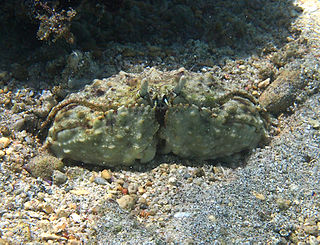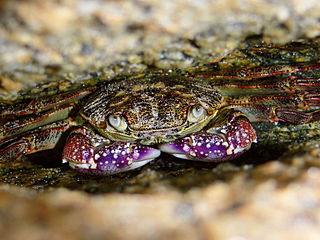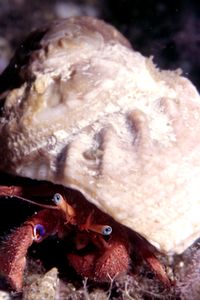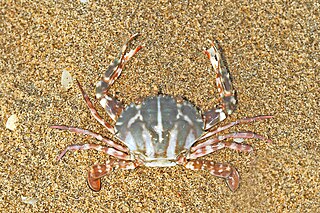
Cancer pagurus, commonly known as the edible crab or brown crab, is a species of crab found in the North Sea, North Atlantic Ocean, and perhaps the Mediterranean Sea. It is a robust crab of a reddish-brown colour, having an oval carapace with a characteristic "pie crust" edge and black tips to the claws. A mature adult may have a carapace width up to 25 centimetres and weigh up to 3 kilograms. C. pagurus is a nocturnal predator, targeting a range of molluscs and crustaceans. It is the subject of the largest crab fishery in Western Europe, centred on the coasts of the British Isles, with more than 60,000 tonnes caught annually.

The Australian flatback sea turtle is a species of sea turtle in the family Cheloniidae. The species is endemic to the sandy beaches and shallow coastal waters of the Australian continental shelf. This turtle gets its common name from the fact that its shell has a flattened or lower dome than the other sea turtles. It can be olive green to grey with a cream underside. It averages from 76 to 96 cm in carapace length and can weigh from 70 to 90 kg. The hatchlings, when emerging from nests, are larger than other sea turtle hatchlings when they hatch.

Charonia is a genus of very large sea snail, commonly known as Triton's trumpet or Triton snail. They are marine gastropod mollusks in the monotypic family Charoniidae.

Grapsus grapsus is one of the most common crabs along the western coast of the Americas. It is known as the red rock crab, or, along with other crabs such as Percnon gibbesi, as the Sally Lightfoot crab.

Calappa is a genus of crabs known commonly as box crabs or shame-faced crabs. The name box crab comes from their distinctly bulky carapace, and the name shame-faced is from anthropomorphising the way the crab's chelae (claws) fold up and cover its face, as if it were hiding its face in shame.

The longhorn cowfish, also called the horned boxfish, is a species of boxfish from the family Ostraciidae, recognizable by its long horns that protrude from the front of its head, rather like those of a cow or bull. They are a resident of the Indo-Pacific region and can grow up to 50 cm (20 in) long.

Leptograpsus variegatus, known as the purple rock crab, is a marine large-eyed crab of the family Grapsidae, found in southern subtropical Indo-Pacific Oceans. It grows to around 50 millimetres (2.0 in) shell width. It is the only species in the genus Leptograpsus.

Mithraculus sculptus, the green clinging crab or emerald crab, is a species of crab in the family Majidae. It is a dark green colour and is found in tropical waters in the Caribbean Sea. It is sometimes kept in reef aquaria.

Conus geographus, popularly called the geography cone or the geographer cone, is a species of predatory cone snail. It lives in reefs of the tropical Indo-Pacific, and hunts small fish. While all cone snails hunt and kill prey using venom, the venom of conus geographus is potent enough to kill humans.

The hawksbill sea turtle is a critically endangered sea turtle belonging to the family Cheloniidae. It is the only extant species in the genus Eretmochelys. The species has a global distribution that is largely limited to tropical and subtropical marine and estuary ecosystems.

Diogenes pugilator is a species of hermit crab, sometimes called the small hermit crab or south-claw hermit crab. It is found from the coast of Angola to as far north as the North Sea, and eastwards through the Mediterranean Sea, Black Sea and Red Sea. Populations of D. pugilator may be kept in check by the predatory crab Liocarcinus depurator.

Ranina ranina, also known as the Huỳnh Đế crab, (red) frog crab or spanner crab, is a species of crab found throughout tropical and subtropical habitats. It is often fished for its meat, and is the only known species in its genus.

Conus ebraeus, common name the black-and-white cone or Hebrew cone, is a species of sea snail, a marine gastropod mollusk in the family Conidae, the cone snails and their allies.

Placetron wosnessenskii, common name the scaled crab, is a species of king crab found in most waters off North America's west coast. It is the only species in the genus Placetron.

Carpilius maculatus, common names seven-eleven crab, spotted reef crab, dark-finger coral crab, and large spotted crab, is a species of crab in the family Carpiliidae, which also includes C. convexus and C. corallinus. While there have reports of the C. maculatus as being poisonous, biochemical testing has revealed that they lack any paralytic shellfish toxins.

Calappa japonica, also known as the Japanese shame-faced crab, is a marine species of box crab in the family Calappidae. Originally found in the waters around Japan, more recently it has been found in Africa, the Red Sea and Western Australia.

Calappa calappa, also known as the smooth box crab or red-spotted box crab, is a tropical marine species of crab with an Indo-Pacific distribution, and showing great variability in its patterning and colouration. First described as Cancer calappa by Linnaeus in 1758 from a specimen originating from Ambon Island, and later in 1781 as Cancer fornicatus by Fabricius, it was finally placed in the genus Calappa by Lancelot Alexander Borradaile in 1903. The name calappa is associated with kelapa, the Malay word for 'coconut'.

Paguristes eremita, the eye spot hermit crab, is a species of hermit crab in the family Diogenidae. It is found in the Mediterranean Sea.

Charybdis feriata, the crucifix crab, is a species of swimming crab in the family Portunidae. It is found in the tropical and subtropical Indo-Pacific region.

Paguristes puncticeps is a hermit crab, in the family Diogenidae. It is found in shallow waters in the tropical western Atlantic Ocean, the Caribbean Sea and the Gulf of Mexico. Like other hermit crabs, it lives inside an empty mollusc shell, which it changes periodically as it grows.























